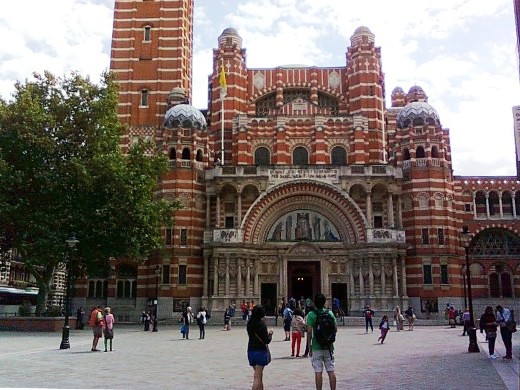
On the way to the next station past Westminster Cathedral.
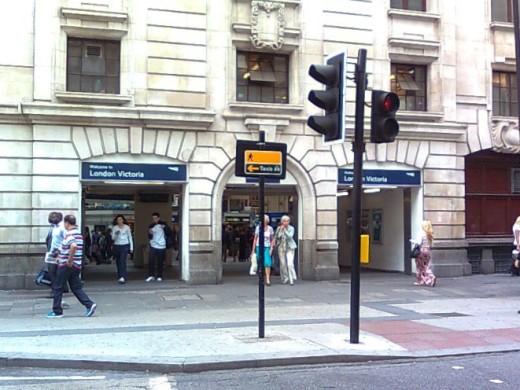
Victoria station is the second busiest on the Underground system, after Waterloo. It consists of two stations connected by a pedestrian passage beneath the bus station. One side serves the Circle and District lines while the deeper, newer station serves the Victoria line. Extensive building work at the front of the station means my going in through the Wilton Road entrance ...
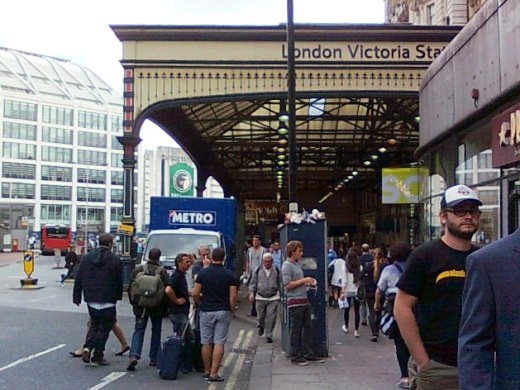
... and out through the Terminus Place entrance.
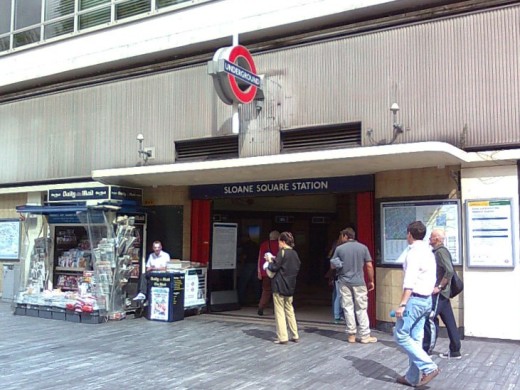
Sloane Square station opened in 1868.
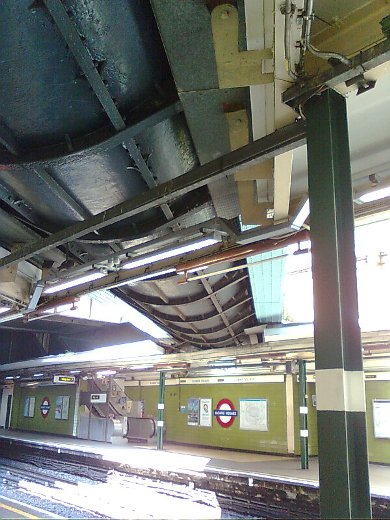
When Sloane Square station was built it was crossed by the River Westbourne which was also the source of the Serpentine in Hyde Park. At the station this large pipe was hung over the platforms to carry the river across.
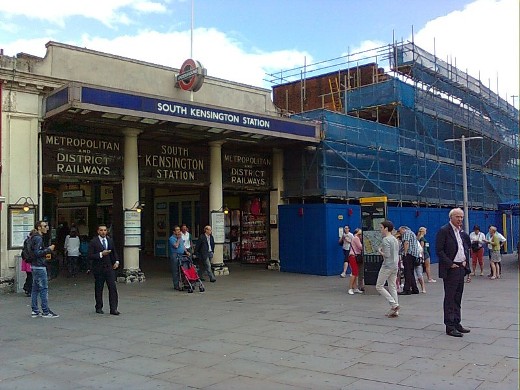
South Kensington station, opened in 1868, with the old station building on the right covered in scaffolding. The Leslie Green station building was built for the deep level Piccadilly line in 1906.
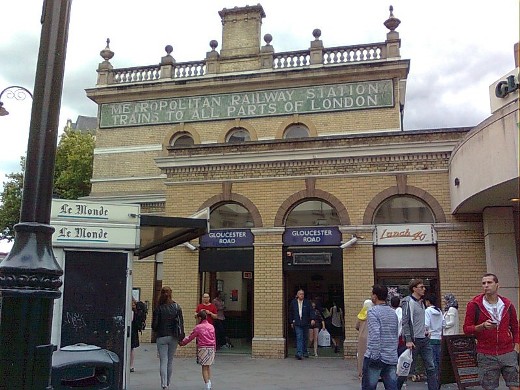
Gloucester Road station was opened in 1868 as Brompton.
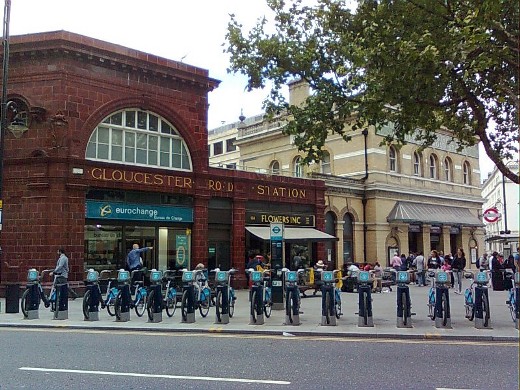
A picture of the two station buildings. The building on the right was the original 1868 building while the one on the left was added in 1906 as the entrance to the deep level Piccadilly line. It is now used for retail purposes.
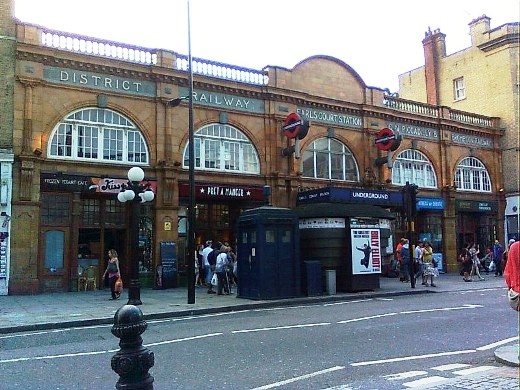
Earl's Court station where the line from Upminster meets the line from Edgware Road. From here branches go to Wimbledon, Kensington (Olympia), Richmond and Ealing Broadway. The station building here was designed by Harry Ford and built in 1915. The words on the building read "District Railway; Earls Court Station; G N Piccadilly & Brompton Railway". The GN stands for General Northern.
In 1911 the Underground's first escalator was built here. The story of a one-legged man named Bumper Harris travelling on the escalator all day in order to demonstrate its safety, sadly appears to be apocryphal as there is no evidence to substantiate it.
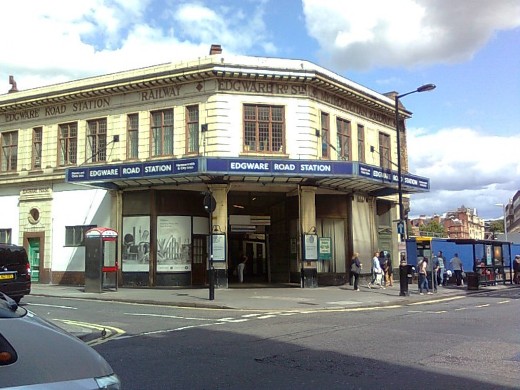
Edgware Road station. Trains run from here down to Earl's Court and on to Wimbledon. Apart from a few short tunnels on the way, the trains run the entire journey either at or above ground level or in open cuttings.
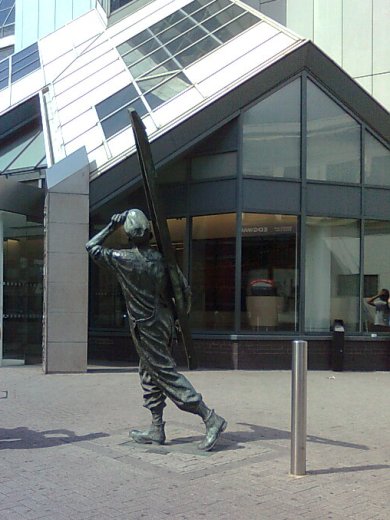
"The Window Cleaner", a sculpture by Allan Sly, standing outside the station looking up at the huge number of windows on the high rise building opposite.
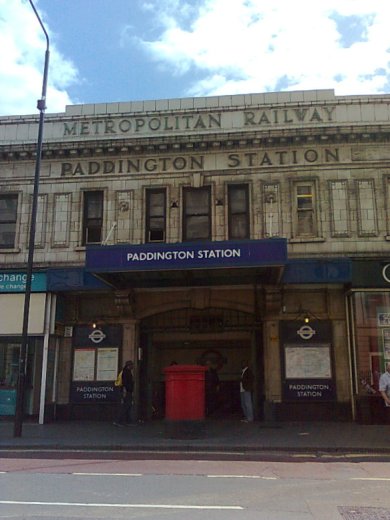
Paddington station, close to but separate from the other Paddington station serving the Circle and Hammersmith & City lines on their way to and from Hammersmith.
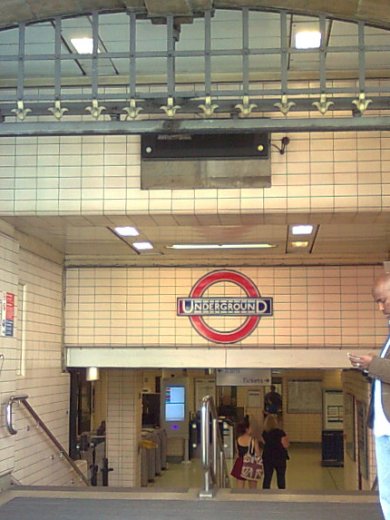
Just inside the station entrance a 1930s style roundel.
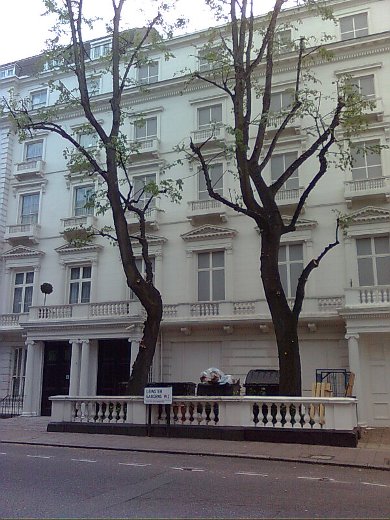
In the late 1860s, numbers 23 and 24 Leinster Gardens were demolished to allow the tube line to run through for a short section where it came to the surface. A false front was built to take the place of the houses. A close look at the windows will show that they are not real. The front doors also do not open.
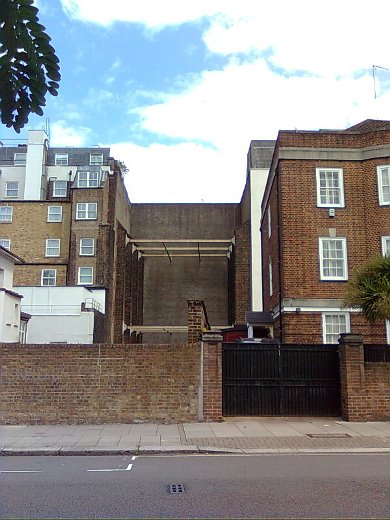
Viewed from the back in Porchester Terrace, the false fronts to the houses can clearly be seen.
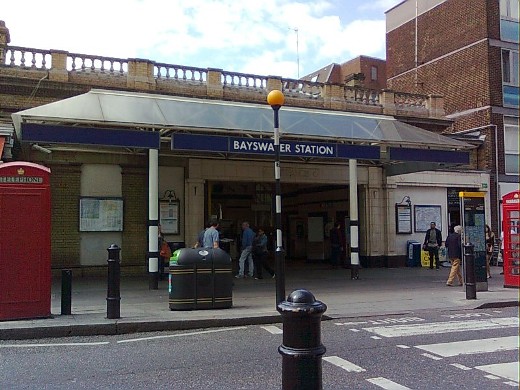
Bayswater station. The line here was built by the cut and cover method. To the west of the platforms a section was left uncovered for ventilation purposes.
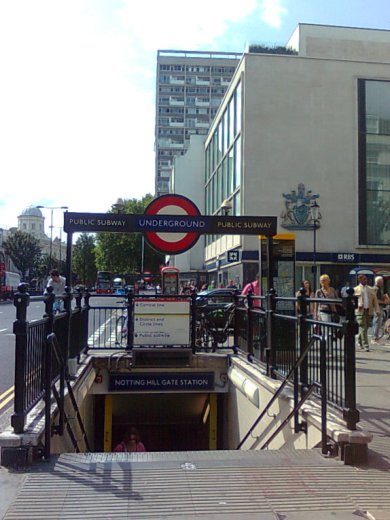
Notting Hill Gate station. The Circle and District line platforms were opened in 1868 and the Central line platforms in 1900. Entrances to the two sets of platforms were originally via separate station buildings on opposite sides of the street. After rebuilding in the 1950s when the two parts of the station were joined, subway entrances were built.
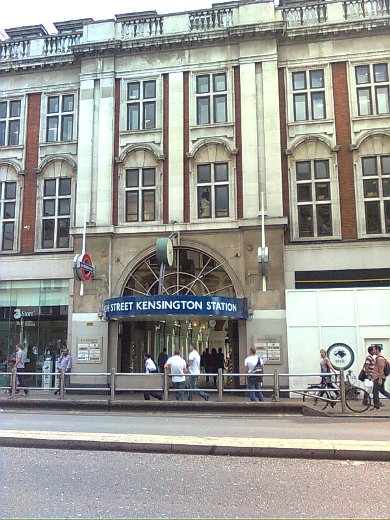
High Street Kensington station. The entrance to the platforms is inside the shopping centre.
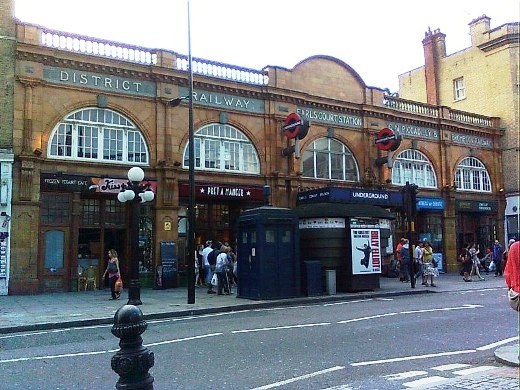
Earl's Court. While the trains from Edgware Road continue on to Wimbledon, other trains go from here to Kensington (Olympia), Richmond and Ealing Broadway.
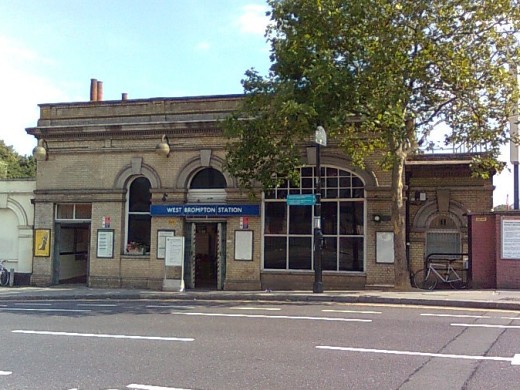
West Brompton station, also served by Southern services and London Overground.
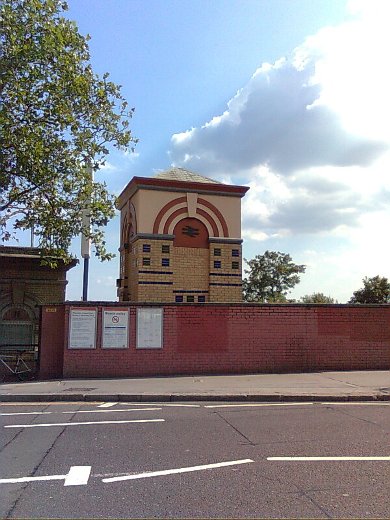
One of two odd-looking brightly coloured buildings standing to the right of the main station building.
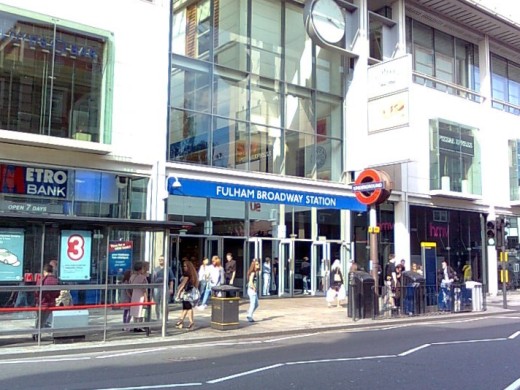
Fulham Broadway station opened in 1880 as Walham Green. The original station building was replaced in 1905 and then closed in 2003. This new entrance was opened down the road with access to the platforms inside the shopping centre.
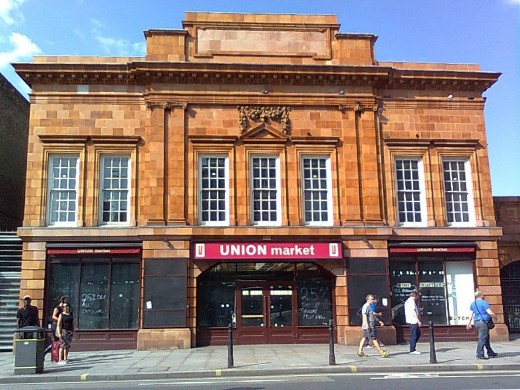
The 1905 station building which replaced the original building was designed by Harry W Ford. It is now a listed building albeit sadly empty.
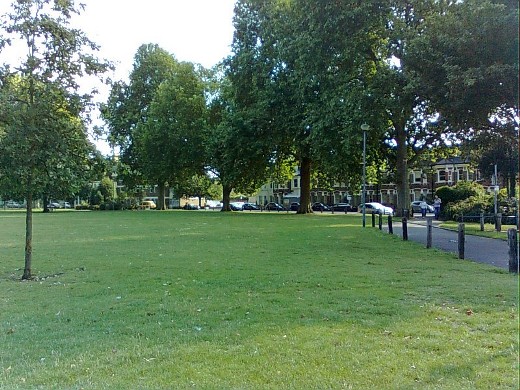
The walk to the next station takes us through Eel Brook Common.
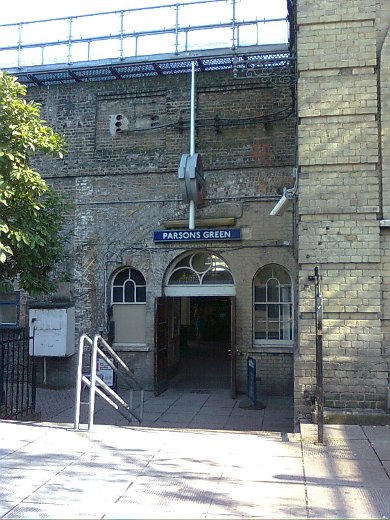
Parsons Green station was designed by Mr Clemence under the supervision of John Wolfe-Barry. Until operations were moved to Earl's Court, Parsons Green was a train-operator depot with seven sidings.
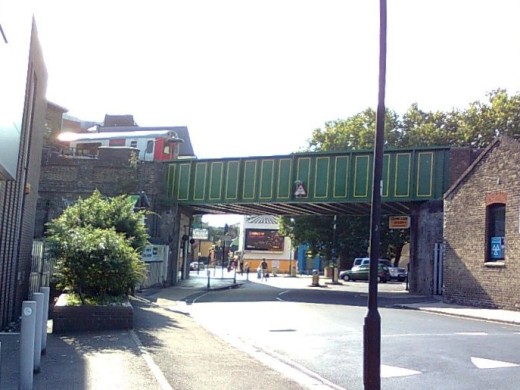
A modern bridge reminds us that the line goes above ground level between Parsons Green and the next station.
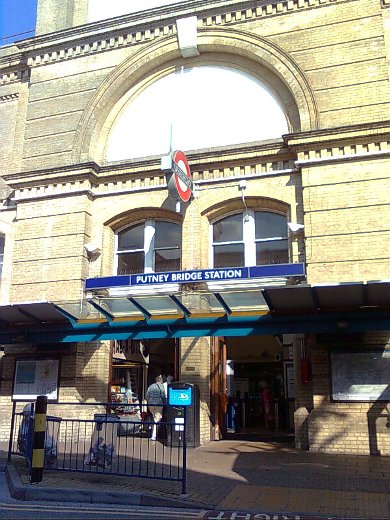
Putney Bridge station opened in 1880 as Putney Bridge & Fulham, changed to Putney Bridge & Hurlingham in 1902 and to Putney Bridge in 1932. The station takes its name from the nearby Thames Putney Bridge and is not in fact in Putney which is south of the river.
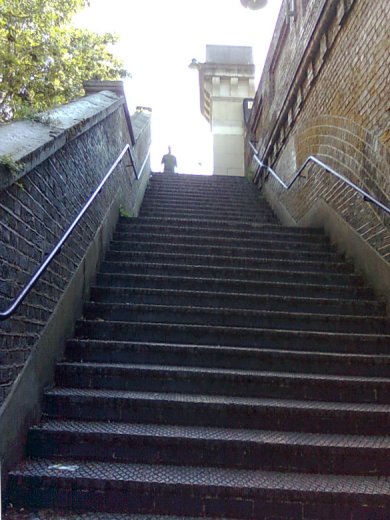
Steps take us up to the footbridge attached to the downstream side of the railway bridge.
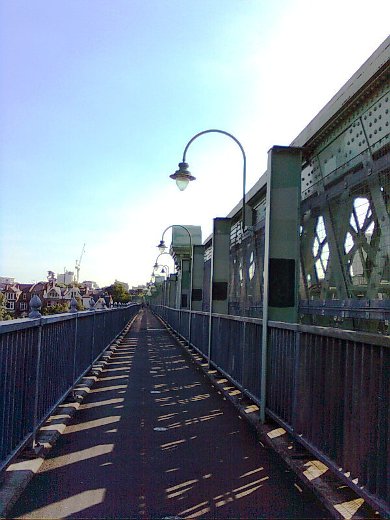
On the footbridge with the railway, only used by District line trains, on the right.
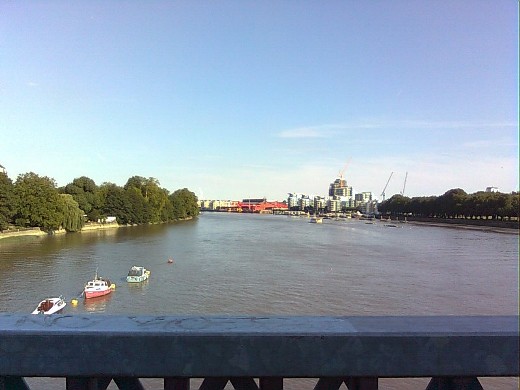
Downstream view from the bridge.
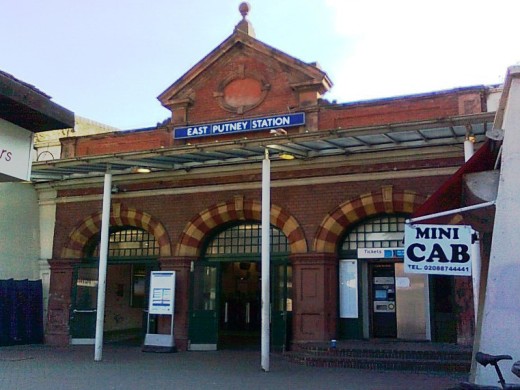
East Putney station.
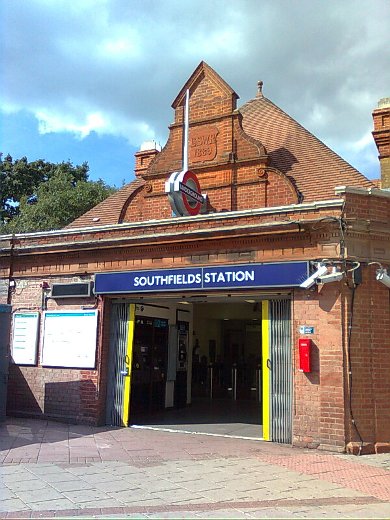
Southfields station, the nearest station for Wimbledon tennis. Each year for the tournament the station platforms are used by a particular company for advertising purposes. For example, in 2006, everything including the floors and benches, was covered in red by American Express. Slightly tasteless I'd have thought.
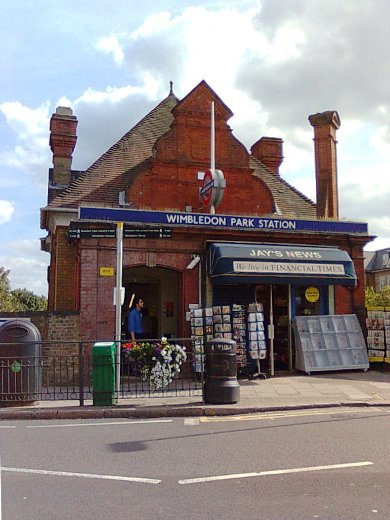
Wimbledon Park station, a mirror image of the previous station although both have had a few alterations.
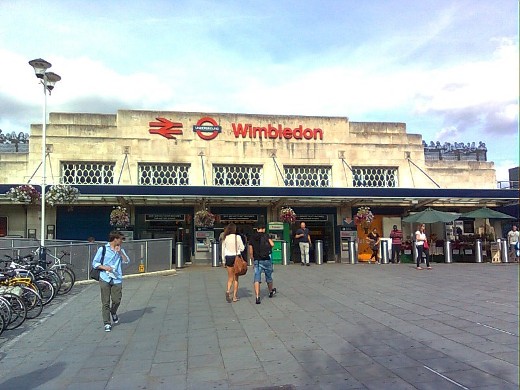
Wimbledon station, served by London Underground, Thameslink and suburban services.
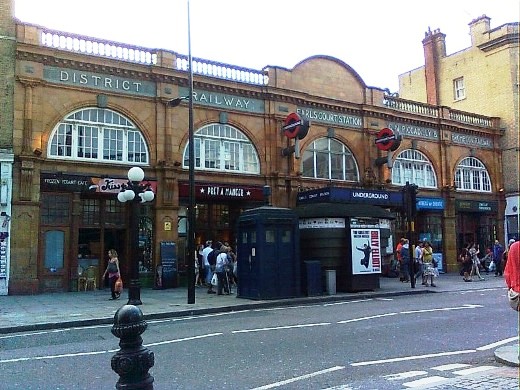
Back to Earl's Court to walk the one stop branch to Kensington (Olympia).
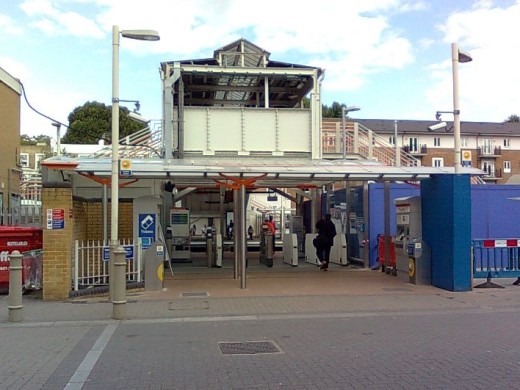
Kensington (Olympia) station is served by the Overground and at certain times by the District line.
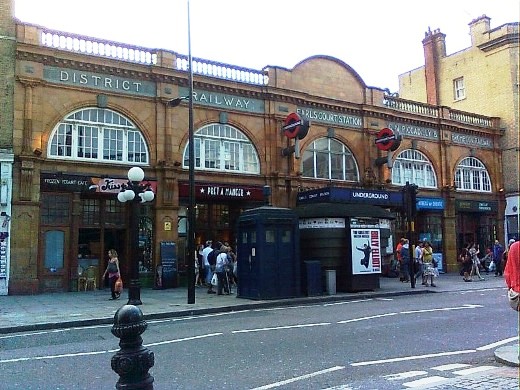
Back to Earl's Court station to follow the line to Turnham Green just after which the line splits and we will walk the two branches in turn.
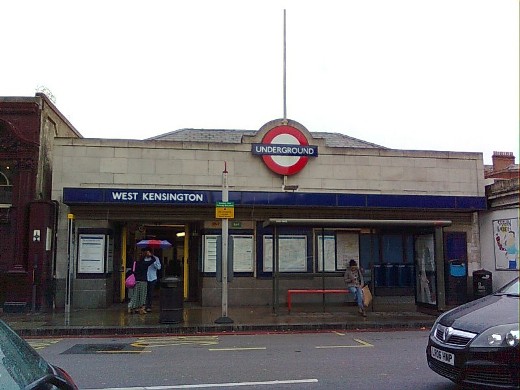
West Kensington station was opened in 1874 as Fulham - North End and was renamed in 1877. The station entrance was rebuilt in 1927 to a Charles Holden design.
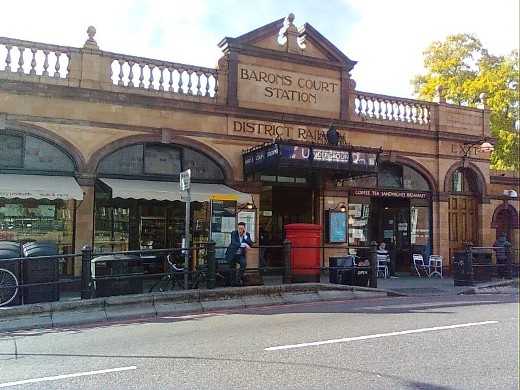
Barons Court station. In 1874 the line was extended from Earl's Court to Hammersmith but the station here was not added until 1905. The station building is a Harry Ford design.
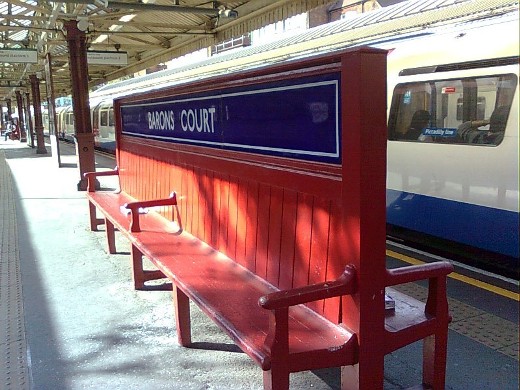
On the platform are impressive wooden benches complete with the station name on enamelled metal panels. These are the only benches like it on the Underground network.
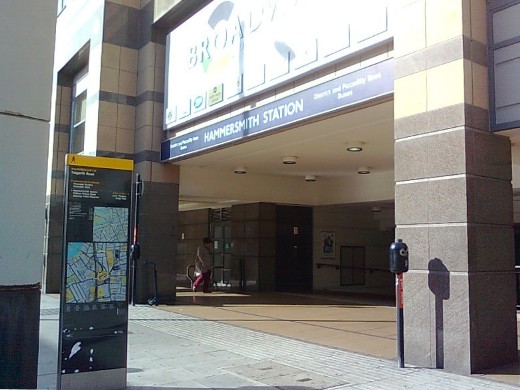
Hammersmith station, served also by the Piccadilly line and completely separate from the Hammersmith station served by the Hammersmith & City and Circle lines. In the early 1990s the station buildings were demolished and the station entrance incorporated into a shopping centre. Parts of the tiling from the original facade were salvaged and included in a decorative mosaic of Hammersmith Bridge which hangs today in the north ticket hall.
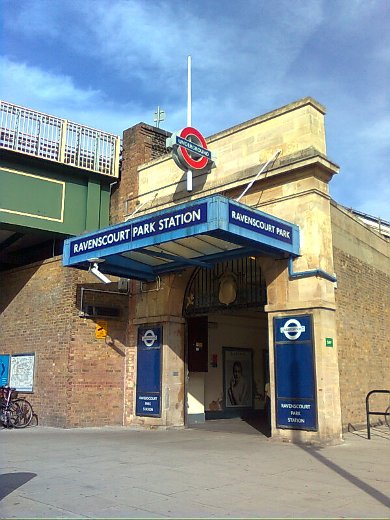
Ravenscourt Park station was opened in 1873 as Shaftesbury Road but it wasn't until 1877 that Metropolitan District Railway trains, now the District line, ran over the London and South Western Railway tracks to Ravenscourt Park and beyond to Richmond. The name of the station was changed to its present name in 1888 just prior to the opening to the public of the nearby park of the same name.
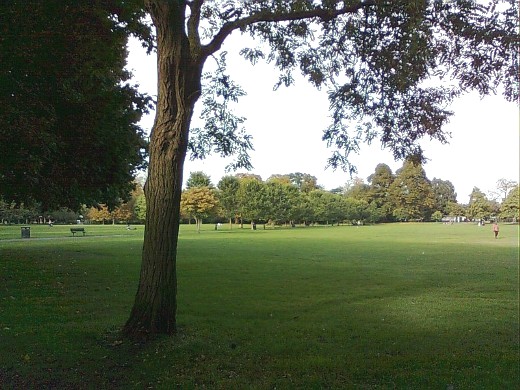
On the way to the next station through Ravenscourt Park.
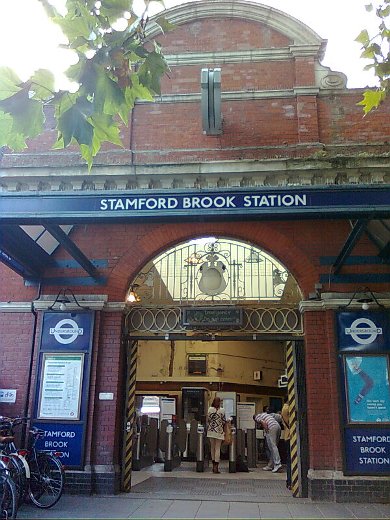
Stamford Brook station, the first tube station to have automatic ticket barriers. They were installed in 1964.
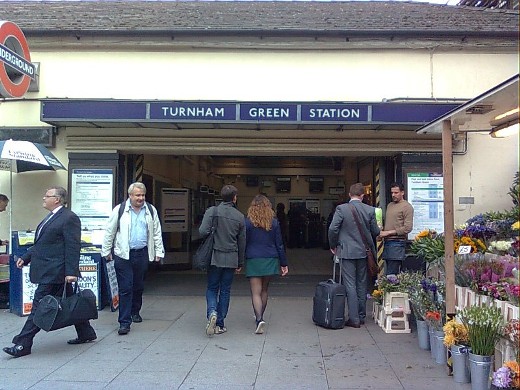
Turnham Green station. From here we will first walk the Richmond branch before returning to follow the Ealing Broadway branch.
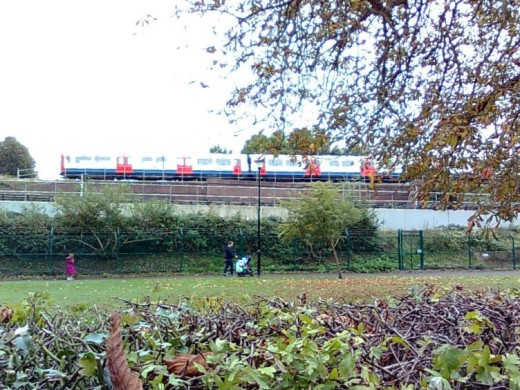
The walk follows the line through Acton Green Common.
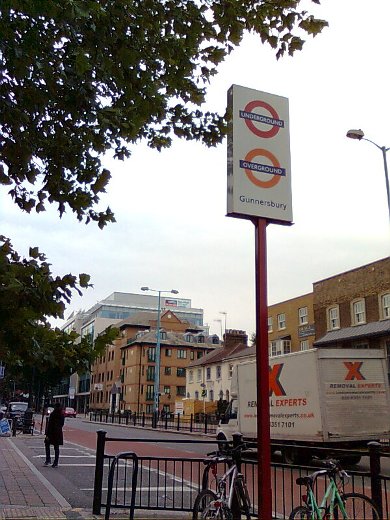
Gunnersbury station was opened as Brentford Road in 1869 by the London & South Western Railway with the name being changed two years later. In 1877 the District line was extended from Hammersmith and connected to the L&SWR tracks near Ravenscourt station. Trains were then run over the tracks to Richmond.
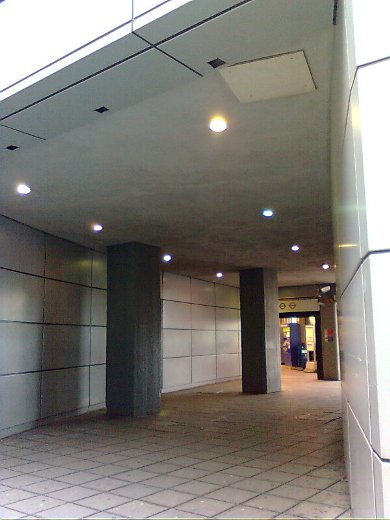
The small and uninteresting entrance to the station is well hidden from the road in an ugly covered walkway round the side of an office block.
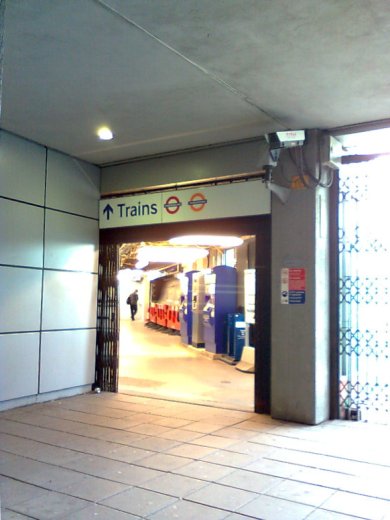
Inside the entrance the station opens up into a long, narrow ticket office.
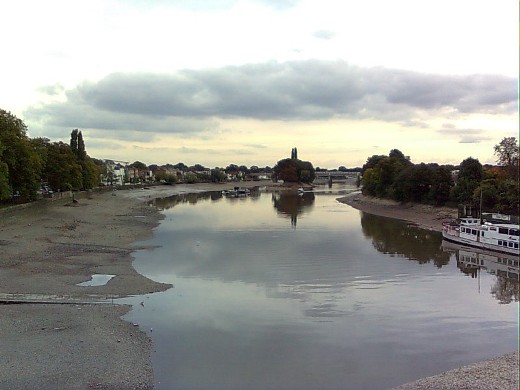
Over Kew Bridge with a view of the railway bridge used by District line trains in the distance.
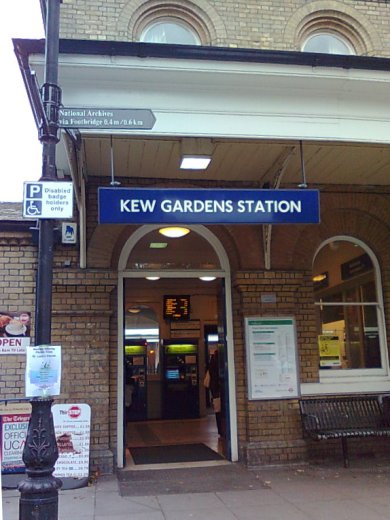
Kew Gardens station, about 500 metres from the entrance to the Royal Botanical Gardens.
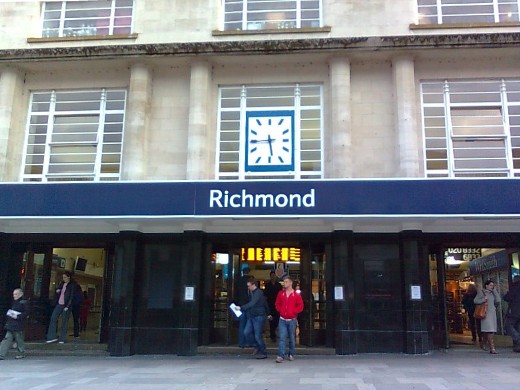
Richmond station, the terminus of this branch of the line. The station building was rebuilt in 1937 in Art Deco style using Portland stone. The station has seven platforms, numbers 6 and 7 being used by the District line.
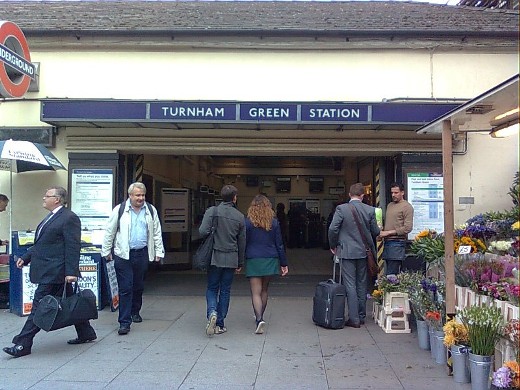
Back to Turnham Green to walk the final few miles of the line to Ealing Broadway.
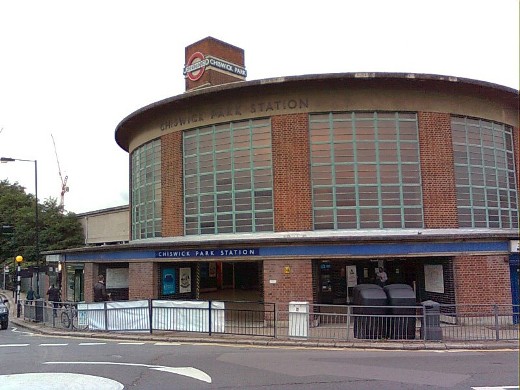
Chiswick Park station, opened in 1879 as Acton Green after the nearby Acton Green Common. It was renamed Chiswick Park and Acton Green in 1889 and Chiswick Park in 1910.
The station was rebuilt in 1931/32 in order to give space for and install new tracks for Piccadilly line trains to run non-stop through the station. The new station building is a Charles Holden design built using brick, reinforced concrete and glass.
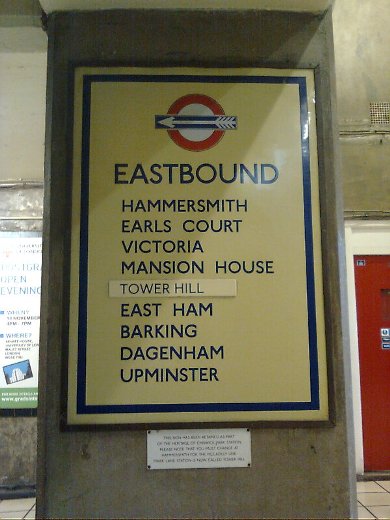
An old sign in the ticket hall with a plaque below explaining that the sign has been retained as part of the heritage of the station. It also reminds us that Tower Hill was once named Mark Lane.
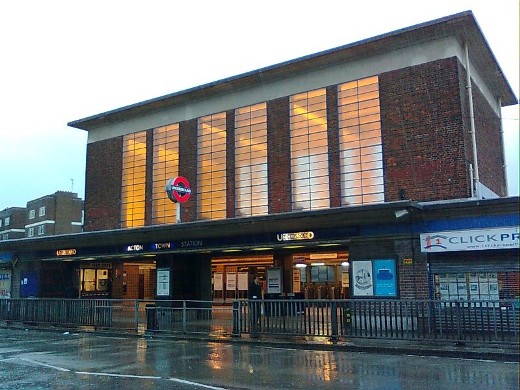
Acton Town station was opened as Mill Hill Park in 1879 and renamed when the station building was rebuilt in 1910.
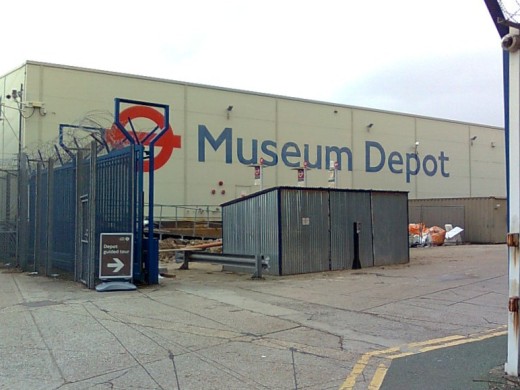
Just north of the station stands the London Transport Museum's storage warehouse known as The Depot. It contains old trains and buses along with old maps, signs and tiles and many other bits and pieces.
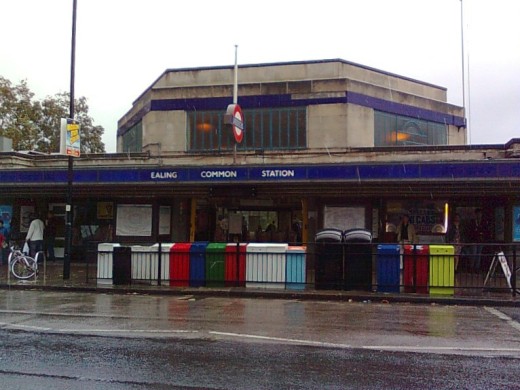
Ealing Common station opened in 1879 as Ealing Common and West Acton and was renamed in 1910. The station building was rebuilt in 1931 to a Charles Holden design. It is constructed of Portland stone.
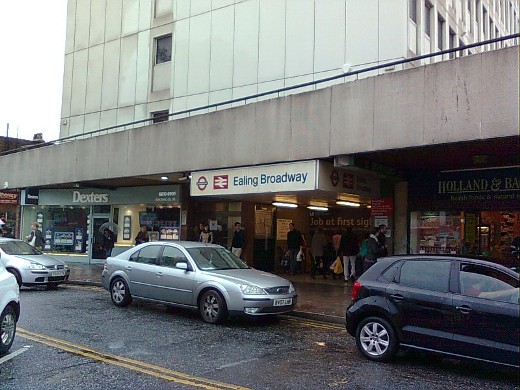
Ealing Broadway station, the western terminus of the District line. It is also the terminus of the Central line. The station building was built in 1970. The station has nine platforms, platforms 7, 8 and 9 being used by District line trains.
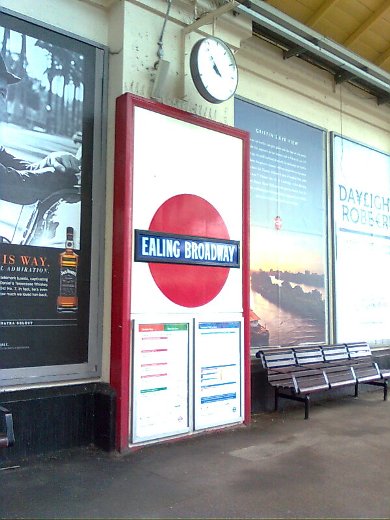
A replica of a 1908 solid roundel on platform 9.


